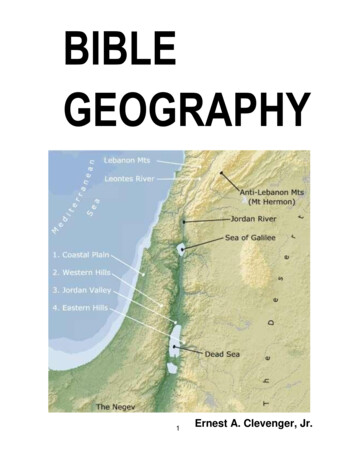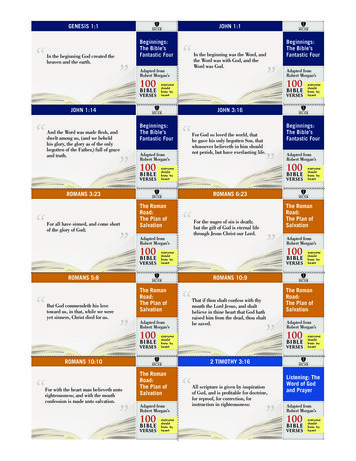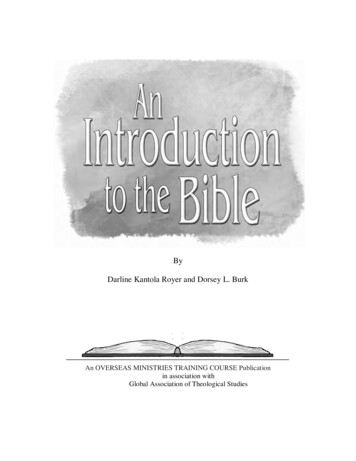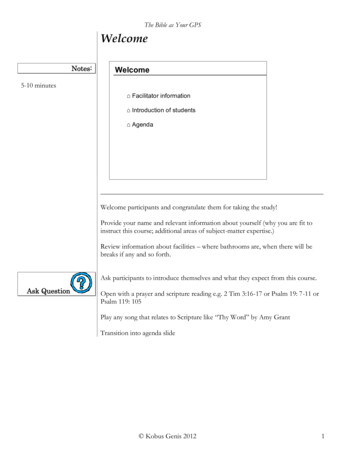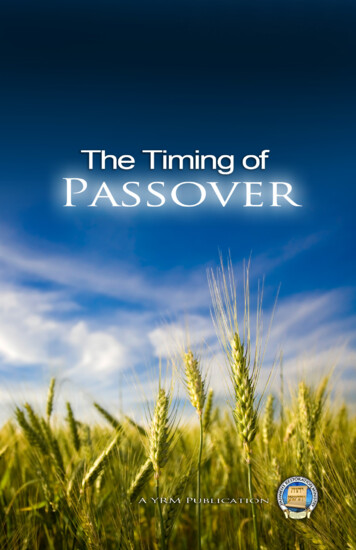
Transcription
POLYGLOTS OF PRINTCATHEDRALSPolyglots:The Bible in Multiple Tongues, 1502-1657Discover the sources, innovations, and uses of these monumentsto early modern devotion, scholarship, and technical skill.This resource will introduce you to the great polyglot Bibles of the early modern period. Thesebooks – editions of the Bible that displayed multiple ancient translations side-by-side – rankamong the most impressive monuments to early modern religious devotion, critical scholarship,and technical craftsmanship. This resource will allow you to engage with these great books anduncover the immense scholarly and technical effort that went into making them, the challengesthat had to be overcome to produce them, and the different ways in which readers actually usedthem.SourcesThese sections describe the raw material for the great polyglots: manuscripts, printed books, andother scholarly materials that polyglot scholars used to make their great books.TranslationsThese fields show the techniques and strategies polyglot scholars adopted to make the manyunfamiliar languages of Scripture accessible and understandable to their readers.ToolsThese sections discuss the wide range of scholarly applications for using the great polyglots, andthe different types of printed works they made possible.“The Age of Great Polyglots”1502-1657Conditions and Challenges Behind the Making of the Great PolyglotsCathedrals of PrintPolyglot Bibles had existed since at least the third century, but none could compare with the four“great” polyglot Bibles of the early modern period: the Complutensian (Alcalá de Henares, Spain,1514-1517), Antwerp (1569-1572), Paris (1628-1645), and London (1654-1657) polyglots. Theseeditions – all of them printed in large, folio-sized editions numbering between 6 and 8 volumes –are the printing equivalent of cathedrals: expressions of devotion to God through the highest levelof intellectual and technical mastery. In them, readers encountered the cutting edge of biblicalscholarship and printing technology in books that were meant to bring honor and glory to theThe Newberry 60 West Walton Street Chicago, Illinois 60610 (312) 943-90901
POLYGLOTS OF PRINTCATHEDRALSnations that produced them.Historical BackgroundThe great polyglots represented the major intellectual and cultural trends of the day. Fromhumanism came the desire to create the most accurate biblical text possible in its originallanguages, from the Reformation came the impetus to evangelize and unite Christendom usingthe Bible, from increasing cultural exchanges with the Ottoman empire came the interest in NearEastern languages, and from print culture came the resolution that all this could be accomplishedthrough the printed word. Polyglots united all these strands of cultural history in the serviceof religion, and the work behind them went on to fundamentally shape intellectual culture forcenturies.The historical and cultural impact of the great polyglots is somewhat overlooked today. In largepart, this is due to the fact that the massive collective effort behind these books is hidden bythe printed page. This resource will draw back the curtain on the stories behind the three greatpolyglots in the collection of the Newberry Library: the Complutensian, the Antwerp, and theLondon.In what follows, you will gain a sense of the individuals who helped create these great books.The Polyglot ProjectIn what follows, you will see biblical scholars, linguists, artists, grammarians, translators, editors,printers, and theologians working to create the editions of the Biblical text in various languages,many of which had never appeared before in print. On the technical side, you will see how printers,compositors, type founders, and engravers worked long hours to display these texts in a clear yetappealing manner. On top of all this, you will learn about how diplomats, bishops, publishers, andpolitical operatives scrambled and cajoled to secure the immense amount of money required tofund these projects. In short, our resource will provide an opportunity to engage with early modernreligious and intellectual history, and also better understand what goes into the making of a greatbook.Complutensian (1517)Alacalá de Henares, SpainThe first great polyglot BibleAt the turn of the 16th century, Cardinal Cardinal Francisco Jiménez de Cisneros was greatlyconcerned with the poor quality of Biblical scholarship in Spain, and resolved to change it throughthe foundation of a university at Alcalá de Henares (Complutense in Latin). There he gatheredexperts in Latin, Greek, and Hebrew – including many conversos, Jewish converts to ChristianityThe Newberry 60 West Walton Street Chicago, Illinois 60610 (312) 943-90902
POLYGLOTS OF PRINTCATHEDRALS– to create an edition of the Bible that included Hebrew, Latin, Greek, and Aramaic versions ofScripture on a single page. It was only in this way, Cisneros claimed in the preface to the work, thatChristians could experience as much of the spiritual power and depth of the Bible as possible.Cisneros spared no expense; between acquiring manuscripts, supporting the team of scholars,creating new print types, and funding the massive effort to print the six folio volumes, theComplutensian cost an estimated 50,000 gold ducats, an immense amount. Money, however,was not the object; the first polyglot Bible was, more than anything else, an expression of religiousdevotion. Cisneros even stipulated in his will that a full copy of the Complutensian Bible was to besold for no more than 6 ½ gold ducats, which guaranteed that his estate would never profit from it.Though the Bible was printed in 1517, the papacy refused to allow the editions to be sold until 1520.Of the 600 copies initially printed, only about 150 survive today.Antwerp (1571)Antwerp, BelgiumChristopher Plantin’s royal achievementSix decades after the Complutensian, the Flemish printer and entrepreneur Christopher Plantinresolved to publish another polyglot, both as an act of devotion and as a way to cement hisstatus as the greatest printer of his time. Originally, Plantin suggested printing a new edition ofthe Complutensian, but the advances in biblical scholarship since 1517 called for an entirely newedition that would have four languages: Latin, Aramaic, Greek, and Syriac, a relative newcomerto European biblical scholarship. During the 1560s, Plantin began assembling the resources andscholars needed for the project in his printing shop in Antwerp. But the world in which they workedwas a far different one than the world the Complutensian scholars had known; the events of theReformation had made the act of producing a Bible in its original languages very controversial;Protestants demanded that the Bible be translated from its original languages, while Catholicauthorities insisted that only the Latin Vulgate was needed. Many in the Church opposed Plantin’spolyglot, and religious tensions in the Low Countries threatened to derail the work completely.Eventually, the printer secured the support of Philip II, the king of Spain, who sent the esteemedbiblical scholar Benito Arias Montano to assist with the project. The six-volume Bible was printedbetween 1569 and 1572 in 1200 complete sets at a cost of at least 40,000 crowns, a third morethan what Plantin had originally estimated. The Inquisition scrutinized the work intensely, and didnot allow the Bible to be sold until 1580.London (1657)London, EnglandThe pinnacle of polyglot scholarshipThe last great polyglot Bible came out of the English Civil War. Brian Walton, an Anglican priestand scholar, was one of many intellectuals loyal to the British monarchy who lost his ecclesiasticalposition after the victory of the Parliamentary forces under Oliver Cromwell. Eventually, WaltonThe Newberry 60 West Walton Street Chicago, Illinois 60610 (312) 943-90903
POLYGLOTS OF PRINTCATHEDRALSfound refuge at Oxford University, where he decided to create another polyglot Bible. Walton wasconvinced that providing the people with the Bible in its original languages and most ancienttranslations was the best way to bring order to a faith in chaos. In collaboration with otherscholars – most of whom were also displaced after the war – Walton led the production of themost ambitious polyglot yet, featuring 9 languages (Latin, Greek, Hebrew, Aramaic, Syriac, Arabic,Persian, Ethiopic, and Samaritan). Walton believed that all these versions together would make “thetruest glasses to represent the sense and reading” of Scripture. As Cromwell’s Council of State wasnot interested in supporting the project, Walton and his team turned to the English people instead,soliciting subscriptions from the general public beginning in 1652, with a complete polyglot pricedat 10. By the end of that year alone, 4,000 had been raised. Thanks to this outpouring of publicsupport, the six-volume polyglot was printed on time between 1654 and 1657. Although not nearlyas aesthetically pleasing as its predecessors, the London polyglot bettered them all in terms of itsscholarly impact; Walton’s edition and his introductory material were indispensable texts for biblicalstudies well into the 19th century.123467895The Newberry 60 West Walton Street Chicago, Illinois 60610 (312) 943-9090104
POLYGLOTS OF PRINTCATHEDRALSComplutensian (1517) Elements1. Finding Fullness of the WordPolyglot scholars promoted understanding Hebrew---. Hebrew Vocabulary. Alcalá de Henares, Spain. 1517.Hebrew, believed by many to be God’s language, was a criticalcomponent of any polyglot Bible, and features prominentlyin all of them. Hebrew in particular was to be the centerpieceof the Complutensian polyglot, since Cisneros believed thatit contained the fullest meaning and mystery of God’s Word.Understanding Hebrew depended on understanding its rootwords, the building blocks on which all Hebrew vocabulary (andthus all of Scripture) were built. The Complutensian scholarshoped to promote the learning of Hebrew by including rootwords that were keyed to entries in the Hebrew vocabularylocated in the sixth volume. By learning these words, userscould better grasp the full range of meaning behind the Hebrewlanguage, which would open the door to the deep spiritualmysteries it expressed.Newberry Catalog: brecon.cgi?DB local&v1 1&BBRecID 398508Other Sources: Otero, Andrés Piquer and Pablo Torijano Morales, eds. The Text of the Hebrew Bible andIts Editions: Studies in Celebration of the Fifth Centennial of the Complutensian Polyglot.Supplements to the Textual History of the Bible 1. Leiden: Brill, 2014.2. Making the Hebrew TextScholars use medieval manuscripts to create the Hebrew text---. First Chronicles in Hebrew. Spain. 11th century.All polyglot texts were ultimately based on manuscript copiesof biblical texts. Thanks to its thriving Jewish community,Spain was the leading center of Hebrew scholarship sincethe Middle Ages. Everyone agreed that the highest qualityHebrew manuscripts were produced there, so Cisneros waswell-positioned to acquire the best proof texts on which toThe Newberry 60 West Walton Street Chicago, Illinois 60610 (312) 943-90905
POLYGLOTS OF PRINTCATHEDRALSbase the Complutensian’s Hebrew edition, and the conversosrecruited to produce it – Pablo Coronel, Alfonso de Toledo, andAlfonso de Zamora – all had extensive experience working withthese manuscript sources. Even the later polyglots turned toSpanish manuscripts to produce their versions. The manuscriptdisplayed above is the Newberry’s oldest Hebrew manuscript, afragment of the Book of Chronicles that was made in Spain atsome point in the 11th century.Newberry Catalog: brecon.cgi?DB local&v1 1&BBRecID 961738Other Sources: Ortega-Monasterio, Teresa. “Spanish Biblical Hebrew Manuscripts.” Hebrew Studies, 45 (2004),163-74.3. The VulgateThe standard Latin translation of the Bible poses a challenge to polyglot scholars---. [Bible][Manuscript]. France(?). Ca. 1230-1250.Throughout the Middle Ages, the dominant version of the Biblewas the Latin translation made in the 4th century that wasattributed to St. Jerome. By the 16th century, scholars agreedthat it was a very problematic text, filled with questionabletranslations and 1,000 years of inherited scribal errors thatscholars were eager to fix. The Roman Church, however,considered the Vulgate the definitive translation, and forbadeanyone from making a corrected edition. As a result, theComplutensian scholars built their edition of the Vulgate frommedieval manuscripts in Spain, none of which were complete.The Vulgate shown here is a complete version of a 13th-centurymanuscript of the Vulgate from France.Newberry Catalog: brecon.cgi?DB local&v1 1&BBRecID 814053Other Sources: [Evangelistary] [manuscript]. Germany, between 1050 and 1100. VAULT folio Case MS 4The Newberry 60 West Walton Street Chicago, Illinois 60610 (312) 943-90906
POLYGLOTS OF PRINTCATHEDRALS4. The SeptuagintThe Greek translation of the Old Testament gains new life in the polyglots---. [Psalterium Graeco-Latinum cum canticis]. Milan, Italy.1481.Centuries before the birth of Christ, Greek-speaking Jews livingin Egypt created a Greek translation of the Old Testament calledthe Septuagint, so-called because around 70 (Septuagint isthe Latin word for 70) scholars produced it. During the MiddleAges, the Septuagint was relatively unknown in westernEurope, where Jerome’s Vulgate translation dominated.Interest in learning and using Greek in religious studies grewthroughout the 14th and 15th centuries, especially after the fallof Constantinople to the Ottoman Turks in 1453. Thereafter,Biblical material in Greek began to appear in print, beginningwith the psalter pictured here. Inspired by this, Cisnerosborrowed Septuagint manuscripts from the Vatican to producethe first printed edition of the entire Septuagint Old Testamentin his polyglot.Newberry Catalog: brecon.cgi?DB local&v1 1&BBRecID 400646Other Sources: O’Connell, S. From Most Ancient Sources: The Nature and Text-Critical Use of the Greek OldTestament Text of the Complutensian Polyglot Bible. Fribourg/Göttingen: Vandenhoeck andRuprecht, 2006.5. AramaicScholars use medieval manuscripts to locate the first translation of Old Testament---. Targum Onkelos of the Pentateuch. Italy. 14th century.To represent as much of the divine mystery as possible, theComplutensian scholars decided to include the Targum, aparaphrase of the Hebrew Scriptures in Aramaic, the languagethat Jews spoke after classical Hebrew died out as a spokenvernacular. Manuscripts of it – such as this example from theThe Newberry 60 West Walton Street Chicago, Illinois 60610 (312) 943-90907
POLYGLOTS OF PRINTCATHEDRALSNewberry’s collections – were widely used in Jewish synagoguesthroughout Europe to explain and interpret the Hebrew text.The Targum was both a translation and an explanation,incorporating commentary from generations of rabbis andeven some Talmudic fables along with the text. This made itsomewhat difficult to use as a source for a definitive text of theBible, and the Complutensian only included the Targum forthe first volume of the Bible (which contained the Pentateuch).Later polyglots would include the entire Targum, after moreeditorial work had been done.Newberry Catalog: brecon.cgi?DB local&v1 1&BBRecID 124482Other Sources: Münster, Sebastian. Arukh : dictionarium chaldaicum non ta[m] ad chaldaicos interpretesq[uam] rabbinoru[m] intelligenda co[m]mentaria necessarium. Basel, 1527. VAULT CasePJ4937 .M86 1527 6. Learning GreekPolyglots bring Greek into conversation with Hebrew for first time---. Sefer Tehilim Psalterium Hebraicum. Basel, Switzerland.1563.Polyglot scholars hoped that their readers would study theBible in all the languages presented in these books, but theyrecognized the fact that few Europeans (even educated ones)were able to do so. Care was always taken to provide Latintranslations of these other languages, so that users could seehow the different languages related to each other. DemetriusDucas, the Greek scholar tasked with preparing the Septuagintedition in the Complutensian, included a Latin translation thatdiffered considerably from the Vulgate translation next to it. Hehoped to inspire the same sort of work we see in the HebrewPsalter pictured here, in which scholars were comfortable usingLatin, Hebrew, and Greek to understand the text of the Bible.The Newberry 60 West Walton Street Chicago, Illinois 60610 (312) 943-90908
POLYGLOTS OF PRINTCATHEDRALSNewberry Catalog: brecon.cgi?DB local&v1 1&BBRecID 952285Other Sources: Fernández Marcos, Natalio. “Greek Sources of the Complutensian Polyglot.” Jewish Receptionof Greek Bible Versions: Studies in Their Use in Late Antiquity and the Middle Ages. Tübingen:Siebeck, 2009, 302-315. 7. Calvary on the pagePrinters use page layout to protect the authority of the VulgateChristopher Plantin, printer. Plantin Polyglot. Antwerp, Belgium.1571.Not everyone was excited about polyglots. Many scholars andecclesiastical leaders argued that a polyglot edition would ruinScripture, since it would allow the language of murderers (Jews)and heretics (Greeks) to distract readers from the essential Latintext. The Complutensian scholars refused to leave out theseoriginal languages, but placed the Vulgate in the very center ofthe page, with the Hebrew and Greek alongside. They describedit as a representation of the Crucifixion, with Christ flanked bythieves on either side. As the image shows, the Plantin Polyglottakes the same visual approach in order to appease the Catholicchurch. Due to its Protestant origin, the London Polyglot did notbother with this, giving more prominence to the other originallanguages.Newberry Catalog: brecon.cgi?DB local&v1 1&BBRecID 234961Other Sources: Fernández Marcos, Natalio. “The First Polyglot Bible.” In The Text of the Hebrew Bible andIts Editions: Studies in Celebration of the Fifth Centennial of the Complutensian Polyglot.Supplements to the Textual History of the Bible 1. Leiden: Brill, 2014, 3-18.8. Making Hebrew TypeLetter-founders create new typefaces for polyglotsThe Newberry 60 West Walton Street Chicago, Illinois 60610 (312) 943-90909
POLYGLOTS OF PRINTCATHEDRALSCongregatio de Propaganda Fide. Alphabeta varia. Rome,Italy. 1630.Many of the languages that appear in polyglots had rarely, ifever, been printed before. This forced early polyglot scholarsto find printers skilled enough to make new print types fromscratch, often using manuscript sources. Arnao Gúillen deBrocar, the printer of the Complutensian polyglot, developed sixnew type fonts for the work using the manuscripts Cisneros hadcollected. A century later, the Catholic church sought to make iteasier to print in these languages by circulating print specimenstaken from particular sources, such as the one pictured here,which printers throughout Europe could use to make their owntypes.Newberry Catalog: brecon.cgi?DB local&v1 1&BBRecID 286133Other Sources: Hall, Basil. The Great Polyglot Bibles. Publication number 124 of the Book Club of California.San Francisco: Published for its members by the Book Club of California, 1966.9. Learning God’s LanguagePolyglots make widespread study of Hebrew more availableJohann Forster. Dictionarium Hebraicum nouum. Basel,Switzerland. 1557.By making available definitive texts of the Bible in its originallanguages, polyglot scholars hoped to inspire other intellectualsto learn to use these languages on their own, so that the qualityof Christian scholarship would grow. We can see this in actionin the Newberry’s copy of the Complutensian; an early userwrote Latin translations over the Hebrew words in this copy thatare different from the Vulgate, which suggests that he usedthe book to learn Hebrew. In the process, he may have madeuse of a Latin-Hebrew dictionary like the one compiled by thescholar Johann Forster, who proudly claimed that his dictionarywas based solely on biblical sources, which the Complutensianprovided in abundance.The Newberry 60 West Walton Street Chicago, Illinois 60610 (312) 943-909010
POLYGLOTS OF PRINTCATHEDRALSNewberry Catalog: brecon.cgi?DB local&v1 1&BBRecID 182836Other Sources: Bell, Dean Phillip. Jews in the Early Modern World. New York: Rowman & Littlefield, 2008, 227230.10. Interpretive EditionsPolyglot editors interpret Hebrew before printing itRabbi David Kimhi. Liber Michlol. Paris. 1540.Classical Hebrew is composed of only consonants in its writtenform; readers could decide which vowels to supply when readingit, which could dramatically alter the meaning of the word. Thisforced editors to make decisions about how certain words couldbe interpreted, especially when they were compared with theLatin or Greek versions. Scholars did this by relying on Hebrewgrammars, which offered guidance on how particular wordsought to be pronounced. The Complutensian scholars reliedespecially on the work of Rabbi David Kimhi, an influentialmedieval grammarian whose work remained popular in the earlymodern period, as evidenced by the printed example shownhere.Newberry Catalog: brecon.cgi?DB local&v1 1&BBRecID 483893Other Sources: Reuchlin, Johann. De accentibus et orthographia linguae Hebraicae. Haguenau, 1518. VAULTCase PJ4581 .R4 1518The Newberry 60 West Walton Street Chicago, Illinois 60610 (312) 943-909011
POLYGLOTS OF PRINTCATHEDRALSAntwerp (1571) Elementsnumbered on image13562741.The Syriac BiblePolyglot scholars seek out manuscripts of a new biblical language---. Syriac Gospel Lectionary. 13th-15th century.During the age of the great polyglots, scholars were keen tobring in any new ancient biblical languages that came to theirattention. The first of these was Syriac, which was introduced toEuropeans at the Fifth Lateran Council (1512-1517). Syriac was aliterary language that was very close to Aramaic (though it hada different alphabet), and scholars were convinced that this wasthe language spoken by Christ, Mary, and the apostles. Moreimportantly for polyglot creators, the first translation of the NewTestament was into Syriac, in a version known as the Peshitta.Scholars and printers throughout Europe were eager to bring thisThe Newberry 60 West Walton Street Chicago, Illinois 60610 (312) 943-909012
POLYGLOTS OF PRINTCATHEDRALSearly translation into print, and acquired manuscripts to makethe necessary typefaces. Plantin’s polyglot used a 13th-centurycopy of the Peshitta; the Newberry’s copy shown here datesfrom the same time.Newberry Catalog: brecon.cgi?DB local&v1 1&BBRecID 844229Other Sources: Contini, Riccardo. “Gli inizi della linguistica siriaca nell’Europa rinascimentale,” in Italia edEuropa nella linguistica del Rinascimento. (Bib ID: 135672), pp. 483-502 Wilkinson, Robert J. The Kabbalistic Scholars of the Antwerp Polyglot Bible. Leiden: Brill, 2007.2. The Polyglot EffectPrinters place as much of the Word of God before readers as possibleHieronymus Megiser. Specimen quinquaginta diversarumatque inter se differentium linguarum, & dialectorum. Frankfurtam Main, Germany. 1603.Polyglot scholars agreed that when it came to printing the Wordof God, more languages were better. Different translations werethought to complement one another, since multiple languagescould reveal more of the divine meaning of Scripture than anysingle language could on its own. This rationale compelledthe Antwerp scholars to add Syriac to the roster of Biblicallanguages in their polyglot, since it would allow the Gospel tospeak in another voice. The introduction of Syriac reflected thegeneral scholarly interest in printing the key texts of Christianityin as many languages as possible. The book shown here,for instance, gave readers 50 different versions of the Lord’sPrayer in various languages and dialects. It was compiled byHieronymous Megiser, a German historian and philologistwho was interested in spreading the polyglot effect throughdictionaries, grammars, and even a polyglot thesaurus.Newberry Catalog: brecon.cgi?DB local&v1 1&BBRecID 666622Other Sources: Guillaume Postel, Lingvarvm duodecim characteribvs differentivm alphabetvm, introdvctio,ac legendi modus longè facilimus . Paris, 1538.The Newberry 60 West Walton Street Chicago, Illinois 60610 (312) 943-909013
POLYGLOTS OF PRINTCATHEDRALS3. Philology and Near Eastern StudiesPolyglots open up new fields of study using Near Eastern languagesJoseph Scaliger. De emendatione temporum. Paris, France.1583.Polyglots played a large role in increasing the presence of NearEastern languages in scholarship. In particular, the typefacesdesigned to print unfamiliar languages often enjoyed longcareers printing works of history, linguistics, and ethnography.The typefaces used to print the Syriac text in the Antwerppolyglot were passed down to Plantin’s son-in-law, FransRaphelengius, who used them to print a revised edition of theFrench scholar Joseph Scaliger’s De emendatione temporum.This book, which charts out human history using ancientcalendar systems, shared the same intellectual spirit as thepolyglots, as it placed the histories of Near Eastern peoples(Jews, Babylonians, Persians, Egyptians, etc.) alongside that ofthe Greeks and Romans.Newberry Catalog: brecon.cgi?DB local&v1 1&BBRecID 656475Other Sources: Edward Rowe Mores, A Dissertation upon English Typographical Founders and Foundries.London, 1778.4. Transliterating New LanguagesScholars use Hebrew to unlock other Near Eastern languagesJohann Widmanstetter, ed. Syriacae lingvae Iesv Christo,eivsque Matri Virgini atq; Iudaeis omnibus, Christianaeredemptionis Euangelicaeq́ Vienna. 1555.Christians in Europe assumed that Near Eastern Christianswere backward, misguided, and ignorant of Christian doctrine.In part, the polyglots were made to help Europeans learn thelanguages needed to minister to their wayward brethren. Syriacwas one of these, but, like many Near Eastern languages,hardly anyone in Europe was familiar with it. To get around thatThe Newberry 60 West Walton Street Chicago, Illinois 60610 (312) 943-909014
POLYGLOTS OF PRINTCATHEDRALSproblem, polyglot scholars used more familiar languages tohelp readers access unfamiliar ones. For the Antwerp polyglot,Plantin’s collaborators decided to transliterate the Peshittainto Hebrew, so scholars could begin to grasp how the Syriacalphabet worked. They could then use the accompanyingLatin paraphrases to translate it. In so doing, Plantin’s teamfollowed the same approach taken by Johann Widmanstetter,the first European to print the Peshitta in 1555. That edition wasaccompanied by this short text, which used Hebrew and Latin tohelp scholars master the Syriac alphabet.Newberry Catalog: brecon.cgi?DB local&v1 1&BBRecID 793622Other Sources: Wilkinson, Robert J. Orientalism, Aramaic, and Kabbalah in the Catholic Reformation: TheFirst Printing of the Syriac New Testament. Leiden: Brill, 2007.5. Royal PatronagePolyglots as signs of political powerPieter van der Heyden. Biblia sacra. Antwerp, Belgium. 1571.Due to their extremely high cost, all of the great polyglotsrequired the assistance of the state. This forced their creatorsto play delicate games of diplomacy between secular andecclesiastical authorities in order to finish them. Plantin had amore difficult time than most; many of the contributors to theproject (including Plantin himself) were suspected Protestants.A crisis ensued when, with the polyglot project well under way, aProtestant revolt in the Netherlands led to a brutal repression bythe Spanish in 1567. Plantin faced financial ruin in the aftermath,but he used the polyglot to save himself (and his business),pitching it as both a monument of Catholic piety and a scholarlytool to combat Protestantism. His rebranding efforts won thesupport of Philip II, who ensured that the project would becompleted. The spectacular frontispiece in the first volume ofthe finished edition commemorated Philip’s support.Newberry Catalog: brecon.cgi?DB local&v1 1&BBRecID 234961The Newberry 60 West Walton Street Chicago, Illinois 60610 (312) 943-909015
POLYGLOTS OF PRINTCATHEDRALSOther Sources: ---. Correspondance de Christophe Plantin, Epp. 39-47.6. Greek ManuscriptsPolyglot editors reveal the Greek New Testament---. Gospels. 12th century.Knowledge of Greek was at the heart of the scholarly culturethat produced the great polyglots. The original language of theNew Testament, Greek had been a staple of biblical scholarshipin Europe since the end of the 15th century. Although someGreek manuscripts could be found in medieval libraries, theybecame more widely available after the fall of Constantinopleto the Ottoman Turks in 1453, when refugees brought theirbooks with them to new homes in Europe. Polyglot scholarsattempted to find the oldest possible Greek manuscripts tomake their editions, and would have been happy to have theNewberry’s 12th-century copy of the Greek Gospels.Newberry Catalog: brecon.cgi?DB local&v1 1&BBRecID 160179Other Sources: Erasmus, Desiderius. Novum Instrumentum. Basel, 1516.7. Acquiring ManuscriptsPolyglot editors depend on merchants and diplomats to acquire sources neededOgier
2. Making the Hebrew Text Scholars use medieval manuscripts to create the Hebrew text---. First Chronicles in Hebrew. Spain. 11th century. All polyglot texts were ultimately based on manuscript copies of biblical texts. Thanks to its thriving Jewish community, Spain was the leading center of Hebrew scholarship since the Middle Ages.



